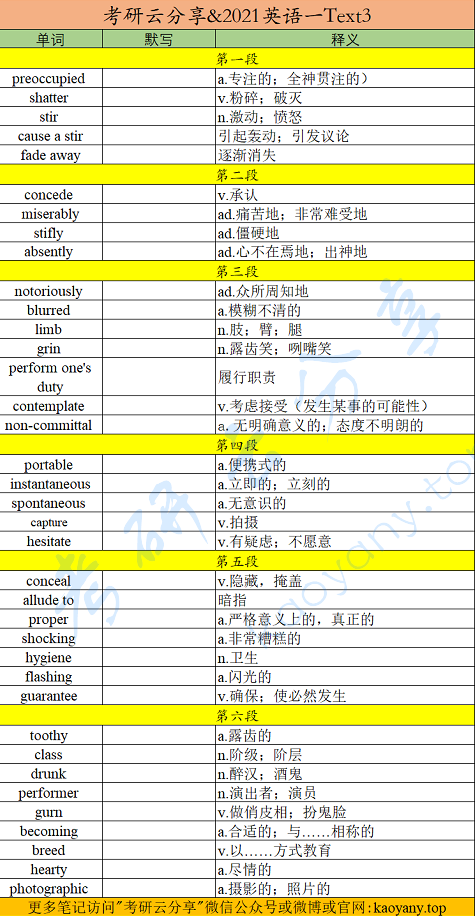第一段
①As a historian who’s always searching for the text or the image that makes us re-evaluate the past, I’ve become preoccupied with looking for photographs that show our Victorian ancestors smiling (what better way to shatter the image of 19th-century prudery?).②I’ve found quite a few, and—since I started posting them on Twitter—they have been causing quite a stir.③People have been surprised to see evidence that Victorians had fun and could, and did, laugh.④They are noting that the Victorians suddenly seem to become more human as the hundred-or-so years that separate us fade away through our common experience of laughter.
单词&词组
preoccupied a.专注的;全神贯注的)
shatter v.粉碎;破灭
stir n.激动;愤怒
cause a stir引起轰动;引发议论
fade away逐渐消失
本段翻译
作为一名史学工作者,我一直在搜寻能让我们重新评价历史的文章或图片,我专注于寻找展现我们维多利亚时代祖先笑容的照片(哪还有更好的方法来打破19世纪拘谨的形象呢?)。我找到了不少,而且自从我把这些照片发布到推特上以后,它们就持续引发热议。人们惊讶地发现,维多利亚时代的人玩得很开心而且确实会笑。人们还注意到维多利亚时代的人似乎突然变得更有人情味儿了,因为我们之间相隔的这100.多年因我们共同的欢笑经历而逐渐消失。
第二段
①Of course, I need to concede that my collection of ‘Smiling Victorians’ makes up only a tiny percentage of the vast catalogue of photographic portraiture created between 1840 and 1900, the majority of which show sitters posing miserably and stiffly in front of painted backdrops, or staring absently into the middle distance. ②How do we explain this trend?
单词&词组
concede v.承认
miserably ad.痛苦地;非常难受地
stifly ad.僵硬地
absently ad.心不在焉地;出神地
本段翻译
当然了,我需要承认,我收集的“微笑的维多利亚人”只占了1840至1900年间大量肖像照中的极小一部分。大部分的照片中,被拍摄对象或以痛苦而僵硬的姿势坐在彩绘背景前,或心不在焉地凝视着不远处。我们该如何解释这一现象呢?
第三段
①During the 1840s and 1850s, in the early days of photography, exposure times were notoriously long: the daguerreotype photographic method (producing an image on a silvered copper plate) could take several minutes to complete, resulting in blurred images as sitters shifted position or adjusted their limbs.②The thought of holding a fixed grin as the camera performed its magical duties was too much to contemplate, and so a non-committal blank stare became the norm.
单词&词组
notoriously ad.众所周知地
blurred a.模糊不清的
limb n.肢;臂;腿
grin n.露齿笑;咧嘴笑
perform one's duty 履行职责
contemplate v.考虑接受(发生某事的可能性)
non-committal a.无明确意义的;态度不明朗的
本段翻译
在19世纪40年代至50年代——摄影的早期时代,曝光时间长是众所周知的:达盖尔式摄影法(在镀银的铜盘上制作图像)可能需要几分钟才能完成,当坐着的人改变姿势或者调整四肢时,图像就会变得模糊不清。在摄像机履行神奇的职责时,保持不变的露齿笑简直难以接受,所以面无表情的木然凝视就成了常态。
第四段
①But exposure times were much quicker by the 1880s, and the introduction of the Box Brownie and other portable cameras meant that, though slow by today’s digital standards, the exposure was almost instantaneous.②Spontaneous smiles were relatively easy to capture by the 1890s, so we must look elsewhere for an explanation of why Victorians still hesitated to smile.
单词&词组
portable a.便携式的
instantaneous a.立即的;立刻的
spontaneous a.无意识的
capture v.拍摄
hesitate v.有疑虑;不愿意
本段翻译
但到了19世纪80年代,曝光时间大幅缩短,布朗尼盒式相机及其他便携式相机的投入使用更使曝光时间几近一瞬(虽然按照今天的数码标准,这仍然很慢)。19世纪90年代时,自然的微笑已比较容易捕捉,因此我们必须转而寻找“维多利亚时代的人为何仍不愿微笑”的其他原因。
第五段
①One explanation might be the loss of dignity displayed through a cheesy grin.②“Nature gave us lips to conceal our teeth,” ran one popular Victorian maxim, alluding to the fact that before the birth of proper dentistry, mouths were often in a shocking state of hygiene.③A flashing set of healthy and clean, regular ‘pearly whites’ was a rare sight in Victorian society, the preserve of the super-rich (and even then, dental hygiene was not guaranteed).
单词&词组
conceal v.隐藏,掩盖
allude to 暗指
proper a.严格意义上的,真正的
shocking a.非常糟糕的
hygiene n.卫生
flashing a.闪光的
guarantee v.确保;使必然发生
本段翻译
一种解释是做作地露齿笑会显得有失尊严。一则维多利亚时代广为流传的箴言称“自然子我们嘴唇以掩藏牙齿”,这暗示严格意义上的牙科学诞生之前,口腔的卫生状况往往非常糟糕。在维多利亚时代的社会,一口闪闪发亮、清洁健康、整整齐齐的“珍珠般的皓齿”难得一见,那是超级富豪的专属(而即便那样,牙齿卫生也无法保证)。
第六段
①A toothy grin (especially when there were gaps or blackened gnashers) lacked class: drunks, tramps, and music hall performers might gurn and grin with a smile as wide as Lewis Carroll’s gum-exposing Cheshire Cat, but it was not a becoming look for properly bred persons.②Even Mark Twain, a man who enjoyed a hearty laugh, said that when it came to photographic portraits there could be “nothing more damning than a silly, foolish smile fixed forever”.
单词&词组
toothy a.露齿的
class n.阶级;阶层
drunk n.醉汉;酒鬼
performer n.演出者;演员
gurn v.做俏皮相;扮鬼脸
becoming a.合适的;与……相称的
breed v.以……方式教育
hearty a.尽情的
photographic a.摄影的;照片的
本段翻译
露齿一笑(尤其是在牙齿有豁口或发黑时)有失身份:酒鬼、流浪汉和音乐厅里的戏子也许会像路易斯·卡罗尔笔下露着牙龈嬉笑的柴郡猫那般扮着鬼脸、咧嘴大笑,但这种举止与教养良好的人并不相称。即使是马克·吐温这样一个乐于开怀大笑的人,也曾言“说起人像照片,没有什么比一个又傻又蠢的微笑被永久定格更糟了”。
五道题
31.According to paragraph 1, the author’s posts on Twitter_______
A. changed people’s impression of theVictorians
B.highlighted social media’s role in Victorian studies
C.re-evaluated the Victorians notion of public image
D.illustrated the development of Victorian photography
32.Whatdoes author say about the Victorian portraits he has collected?
A.They are in popular use among historians.
B. They are rare among photographs ofthat age.
C.They mirror 19th-century social conventions.
D.They show effects of different exposure times.
33.What might have kept the Victorians from smiling for pictures in the 1890s?
A.Their inherent social sensitiveness.
B.Their tension before the camera.
C.Their distrust of new inventions.
D. Their unhealthy dental condition.
34.Mark Twain is quoted to show that the disapproval of smiles in pictures was________
A. a deep-root belief
B.a misguided attitude
C.a controversial view
D.a thought-provoking idea
35.Which of the following questions does the text answer?
A. Why did most Victorians look sternin photographs.
B.Why did the Victorians start to view photographs.
C.What made photography develop slowly in the Victorian period.
D. How did smiling in photographs become apost-Victorian norm.
参考答案
ABDAA
答案解析
31、第一段②句指出,作者将微笑的维多利亚人的照片发布到推特上后,它们持续引发热议。随后③④句具体阐述:人们惊讶地发现,维多利亚时代的人玩得很开心而且确实会笑;人们注意到维多利亚时代的人似乎突然变得更有人情味儿了。这都表明人们对维多利亚时代人的印象发生了改变,[A]正确。
32、根据题干关键词Victorian portraits he has collected定位至第二段①句。该句指出, 我收集的“微笑的维多利亚人”只占了1840至1900年间大量的肖像照的极小一部分,故[B]正确。
33、根据题干关键词kept the Victorians from smiling和in the 1890s定位至第四段末句。该句指出,19世纪90年代时,自然的微笑已比较容易捕捉,人们拍照时不笑另有他因。第五段继而提出一种可能解释“露齿笑显得有失尊严”并借由古箴言追溯时代背景“当时牙科学尚未诞生,人们的牙齿卫生状况极差”。可见,90年代的人拍照不笑是因为“微笑会暴露牙齿的不健康状态,有失尊严”,[D]正确。
34、题干问及作者引用马克·吐温之言的目的,应到马克·吐温的话语之外寻找作者观点,由此锁定第六段首句。该句首先指出,露齿笑有失身份,也即拍照时不应该笑,随后对比两类人(drunks, tramps, and music hall performers vs properly bred persons) 指出, 粗俗之人才会咧嘴大笑, 而(大笑)这种举止与教养良好的人并不相称。再结合马克·吐温的例子“尽管他喜欢纵情大笑,却认为拍照时微笑是愚蠢之举”,可见“在维多利亚时代,拍照时不得微笑的观念已根深蒂固、深人人心,[A]正确。
35、本文首段介绍作者发现“不少维多利亚人面带微笑的照片”,第二段陈述事实“当时的肖像照中,面带微笑者仅占少数,多数被拍摄者姿势僵硬、表情淡漠”并提出问题“如何解释这一现象?”,第三至六段分别阐释了三个原因“早期的相机曝光时间过长,人们难以保持微笑;当时人们牙齿卫生极差,露齿笑有失尊严;社会普遍认为露齿笑有失身份、缺乏教养”。综合可知,全文旨在剖析“为何大部分维多利亚时代的人拍照不笑/表情严肃”(第二段段末问句即为文章主题),[A]正确。

- 单词 词组
- 本段翻译
- 单词 词组
- 本段翻译
- 单词 词组
- 本段翻译
- 单词 词组
- 本段翻译
- 单词 词组
- 本段翻译
- 单词 词组
- 本段翻译
- 参考答案
- 答案解析
